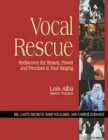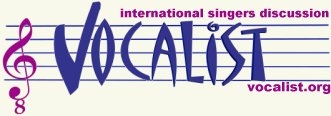|
TITLE
|
Description
|
Bel Canto
The Free Voice
Voice: Psyche and Soma
|
A trilogy from Cornelius L Reid. Essential reading for anyone interested in Bel Canto singing.
|
|
The Modern Singing Master
|

|
Essays in Honour of Cornelius L Reid. A fascinating new publication in 2002. The Modern Singing Master is a compilation of essays written by renowned singing teachers as their testament to their great singing instructor, Cornelius Reid.
|
|
|
Singing and Imagination: A Human Approach to a Great Musical Tradition
|

|
By Thomas Hemsley, this is a comprehensive philosophy of the art of singing, addressed to those with a gift for singing who would like to understand better how to approach putting that gift to use. The central theme is that the imagination is an essential pre-requisite of singing--not an optional extra.
|
|
|
Singing with Your Whole Self
|

|
By Samuel H. Nelson and Elizabeth Blades-Zeller. Teaches performers to use the Feldenkrais Method to ameliorate problems of tension, muscle strain, and illness in order to obtain optimal vocal performance. Singing with your Whole Self contains an important and unique feature: modularized Feldenkrais "Awareness through Movement" lessons. |
|
|
Dynamics of the Singing Voice
|

|
By Meredith Bunch. This work is designed as a reference text for teachers of singing, singers, choral conductors and organists, speech and voice therapists, laryngologists and other health professionals, psychologists and those in linguistics. It discusses the physiological, psychological, musical and also to speaking. |
|
|
Power Performance for Singers
|

|
By Shirlee Emmons, Alma Thomas. Written as a self-help manual for singers at all levels of expertise, Transcending the Performance Barriers is designed to teach performing artists, and especially singers, how to experience elite performance at their level. The skills outlined in this book will help singers use what they have, to enjoy their voices during performance, and to perform consistently to the best of their present ability. |
|
|
Complete Handbook of Voice Training
|

|
By Richard Alderson. Contains specific vocal exercises and tested drills for training the singing voice. |
|
|
TipBook Vocals
|

|
This easy-to-read and highly accessible Tipbook has been written in close collaboration with classical and non-classical singers and teachers, therapists, and other experts. Tipbook Vocals doesn't teach you how to sing, but it supplies you with valuable, practical information that will help you to understand and extend the possibilities of your voice, to appreciate and evaluate input from voice teachers and coaches, and to have easier access to other literature on the subject.
|
|
|
Discover Your Voice: How to Develop Healthy Voice Habits
|

|
Discover Your Voice: How to Develop Healthy Voice Habits by Oren L. Brown is a superb book for singers at any level. Comes with a CD. Brown taught voice at the Juilliard School and was a pioneer in voice therapy. He has expanded the 19-page syllabus for his students into a comprehensive text for self-study, study with a private teacher, or classroom instruction. He speaks of concepts, perceptions, exercises, acoustics, and physiology.
|
|
|
The Diagnosis and Correction of Vocal Faults: A Manual for Teachers of Singing and for Choir Directors
|

|
By James C. McKinney who's teaching lineage can be traced back to the great William Vennard. This book is a resource for the fundamental and thorough knowledge of singing - how to spot and correct vocal faults. Written for teachers, but in a style which students will also understand and benefit from.
|
|
|
The Structure of Singing: System and Art in Vocal Technique
|

|
By Richard Miller, this book is not recommended for beginners. Combining the physical, technical, and artistic aspects of singing, the author applies current findings in medicine, acoustics, phonetics, and speech therapy to the singer's needs. The text demonstrates the scientific basis of exercises and vocalises, covering all major areas of vocal technique.
|
|
|
Training Soprano Voices by Richard Miller
|

|
By Richard Miller, this book is not recommended for beginners or non serious students. A young dramatic soprano should not be forced into a soubrette mold, nor should the soubrette soprano be assigned dramatic tasks. Although all soprano voices have common characteristics, each type has unique features that require a particular approach in teaching. Training Soprano Voices addresses this issue directly by providing a complete and reliable system for training each type of soprano voice. Designed as a practical program for singers, teachers, and voice professionals, it couples historic vocal pedagogy with the latest research on the singing voice. The book emphasizes the special nature of the soprano voice and the proper physiological functioning for vocal proficiency.
|
|
|
Solutions for Singers: Tools for Performers and Teachers by Richard Miller
|

|
By Richard Miller. Internationally recognized master teacher and noted tenor Richard Miller answers over 200 specific questions on voice technique and performance. In this guide to technical security, he offers professional performers, students, and teachers practical means for assisting artistic performance.
|
|
|
Training Tenor Voices by Richard Miller
|

|
By Richard Miller, This text presents a combination of historical and pedagogical information on how tenors sing. It emphasizes the special nature of the tenor voice and the proper physiological function leading to the establishment of vocal proficiency.
|
|
|
National Schools of Singing: English, French, German, and Italian Techniques of Singing Revisited by Richard Miller
|

|
By Richard Miller, In 1977, Scarecrow Press published Richard Miller's study, "English, French, German and Italian Techniques of Singing: A Study in National Tonal Preferences and How They Relate to Functional Efficiency." He compared the historic and then current techniques practiced in the four major Western European schools of vocalism and evaluated technical maneuvers found within each. Recent years have placed greater demands on the vocal talents of professional singers with the growth of performance spaces, the emergence of the stage director, louder orchestral sound, and even the infusion of pop culture sounds into traditional music. As "world culture" continues to expand, and vocal talent becomes more homogeneous, the need for continued recognition of lingering national and regional vocal training techniques becomes more important for the singer's quest to develop a certain style. This update of Miller's original study incorporates these new concerns with a continued investigation into which techniques within the national schools are common to them all and which idiosyncratic regional tendencies remain.
|
|
|
Phonetic Readings of Songs and Arias by Berton Coffin
|

|
By Berton Coffin, authentic pronunciation of 413 Italian, German and French lyrics from "The Singer's Repertoire" in International Phonetic Alphabet transcription.
|
|
|
Principles of Voice Production by Ingo R. Titze
|

|
By Ingo R. Titze - a cross-disciplinary exploration of the physics and physiology of voice production, mechanism, and applied uses and concerns of the voice. Throughout the emphasis is on physical law rather than empirical observation. Key topics include the relation between the physical processes of voice production to other physical processes, inside or outside of the human body, the new field of vocology and clarification of the acoustic and biomechanical laws governing phonation.
|
|
|
Teaching Kids to Sing by Kenneth H. Phillips
|

|
By Kenneth H. Phillips - this book presents a systematic approach to vocal techniques geared exclusively for the younger singer. This research-based text synthesizes the most recent findings in the literature, and presents it in a practical and useable format. It should help teachers of young singers to better understand the nature of the child and adolescent voice, and to provide for a sequence of developmental instruction of vocal skills. The first part provides information on the historical and philosophical perspectives on procedures of vocal training for children grades 1-12. The second part consists of 90 sequential techniques grouped in five major areas: respiration, phonation, resonant tone production, diction, and expression.
|
|
|
Great Singers on Great Singing : A Famous Opera Star Interviews 40 Famous Opera Singers on the Technique of Singing
|

|
Jerome Hines has interviewed 40 singers, a speech therapist, and a throat specialist to provide this invaluable collection of advice for all singers. This collection includes the commentary of Licia Albanese, Franco Corelli, Placido Domingo, Nicolai Gedda, Marilyn Horne, Sherrill Milnes, Birgit Nilsson, Luciano Pavarotti, Rose Ponselle, Beverly Sills, Joan Sutherland and many others. "Probably the best book on the subject." Publishers Weekly
|
|
|
Vocal Rescue: Rediscover The Beauty, Power, And Freedom In Your Singing
|

|
By Lois Alba "No serious singer or voice teacher should be without Vocal Rescue. It should be required reading for everyone involved with opera." Charles Rosekrans, Conductor and Recording Artist with Hungaroton.
• Vocal Rescue provides an in-depth study of the seven vocal secrets of Bel Canto.
• Step-by-step lessons for singers to follow in mastering these principles.
• Rare documented information from original treatises by the earliest masters of Bel Canto starting at the 16th century.
• Specially formulated vocalises; an adaptation of Da Vinci's creative philosophy to the art of singing.
• Guidance for all voice types and extensive role model descriptions.
• Comparisons of classical and contermporary styles of singing and singers.
• Role preparation from the simple to the most complex.
• Suggestions for vocal health.
• Glossary of Bel Canto terms and expressions.
• Recorded illustrations on CD and DVD.
|
|
|
The Science of the Singing Voice (Paperback)
|

|
The Science of the Singing Voice by Johan Sundberg was published in 1987.
"One of the most exciting books on the singing voice to have appeared in this century.... Highly recommended as a unique contribution to voice science." -Choice
"Such an advance, scientifically ... that no serious student of the singing voice and vocal pedagogue should be without it."-ASHA
"Although there are numerous books dealing with the science and acoustics of speech, there are relatively few that deal with the singing voice as distinct from the speaking voice. Now, Johan Sundberg's The Science of the Singing Voice-illustrated with over a hundred instructive and significant diagrams and drawings-thoroughly describes the structure and functions of the vocal organs in singing, from the aerodynamics of respiration through the dynamics of articulation."-The Daily Herald
Table of Contents
1. What Is Voice?
2. The Voice Organ
3. Breathing
4. The Voice Source
5. Articulation
6. Choral Voice
7. Speech, Song, and Emotions
8. A Rhapsody on Perception
9. Voice Disorders
Bibliography
Index
|
|
|
The Science of Vocal Pedagogy (Paperback)
|

|
The Science of Vocal Pedagogy by D.Ralph Appelman was published in 1967.
It is designed to be used as a textbook. The material in it is used as a two-semester course of study. Part One, "Theory," is used during the first semester for undergraduate as well as graduate courses. Part Two, "Application," is used during the second semester in graduate courses in which studio techniques are developed as each class member teaches a high school student.
|
|
|
The Promise of Sleep
|

|
THE PROMISE OF SLEEP illuminates the little understood but vitally important 'forgotten third' of our lives - from the science of our sleeping brain to the coded world of dreams. Drawing on more than four decades of research in sleep science, William C. Dement explains what happens when we sleep, taking readers on a remarkably lively tour of the sleeping body and mind. Dement examines sleep's surprisingly powerful effect on our overall health, from our immune system to our psychological well-being, and alerts us to the many ways in which sleep loss and sleep deprivation can put us in harm's way, inhibiting our motivation and our vitality.
|
|

